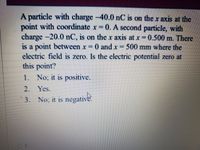
College Physics
11th Edition
ISBN: 9781305952300
Author: Raymond A. Serway, Chris Vuille
Publisher: Cengage Learning
expand_more
expand_more
format_list_bulleted
Question

Transcribed Image Text:A particle with charge -40.0 nC is on the x axis at the
point with coordinate x=0. A second particle, with
charge -20.0 nC, is on the x axis at x = 0.500 m. There
is a point between x 0 and x 500 mm where the
electric field is zero. Is the electric potential zero at
this point?
1. No; it is positive.
2. Yes.
3.
No; it is negative.
01
Expert Solution
This question has been solved!
Explore an expertly crafted, step-by-step solution for a thorough understanding of key concepts.
This is a popular solution
Trending nowThis is a popular solution!
Step by stepSolved in 2 steps with 2 images

Knowledge Booster
Similar questions
- Consider three charges. There is a 5.5 nC charge at coordinates (5.8 m, 0). There is a 6.7 nC charge at coordinates (0, 6.4 m). Lastly, there is a -7.7 nC charge at coordinates (5.8 m, 6.4 m). Calculate the electric potential at the origin, in V. Use k = 9 x 109 N m2 / C2. (Please answer to the fourth decimal place - i.e 14.3225)arrow_forwardA point charge with charge +55.6 nC is at coordinates x = 2.00 m and y = 0.00 m. What is the electric potential at the point (3.00 m, 3.00 m)? A point charge with charge -55.6 nC is at coordinates x = 0.00 m and y = 2.00 m. What is the electric potential at the point (3.00 m, 3.00 m)?arrow_forwardA plastic rod has been bent into a circle of radius R = 9.53 cm. It has a charge Q1 = +4.81 pC uniformly distributed along one-quarter of its circumference and a charge Q2 = -6Q1 uniformly distributed along the rest of the circumference (see the figure). With V = 0 at infinity, what is the electric potential (a) at the center C of the circle and (b) at point P, which is on the central axis of the circle at distance D = 3.61 cm from the center?arrow_forward
- What is the electric potential at the dot in the figure? The charge on Q1 is 4.00 nC, the charge on Q2 is 5.00 nC and the charge on Q3 is 3.00 nC. The distance between charge Q1 and charge Q2 is 7.00 cm. The distance between Q2 and Q3 is 2.00 cm. 2.80×103 V 2.42×103 V 2.18×103 V 1.00×103 Varrow_forwardA 11.5 nC charge is at x = 0 cm and a -1.5 nC charge is at x= 6.0 cm .At what point or points on the x-axis is the electric potential zero?arrow_forwardA plastic rod has been bent into a circle of radius R = 11.0 cm. It has a charge Q1 = + 5.38 pC uniformly distributed along one-quarter of its circumference and a charge Q2 = -6Q, uniformly distributed along the rest of the circumference (see the figure). With V = 0 at infinity, what is the electric potential (a) at the center C of the circle and (b) at point P, which is on the central axis of the circle at distance D = 6.02 cm from the center? D Q2 (a) Number i -2.2 Units V (b) Number -1.93 Unitsarrow_forward
- A +3.0 nC charge is at x=0cm and a -1.0 nC charge is at x=4cm. At what point or points on the x-axis is the electric potential zero?arrow_forwardThree charges, q1 = 8.50 nC, q2 = 3.50 nC and q3 = -5.00 nC are distributed as shown in Figure 1. Charge q2 is a distance 35.0 µm to the right of charge 9₁ and charge q3 is a distance of 25.0 µm to the right of charge 92. What is the electric potential a distance of 10.0 µm to the right of charge 93? 91 92 93 Note: Your answer is assumed to be reduced to the highest power possible.arrow_forwardA small particle has charge -4.30 µC and mass 1.10x10-4 kg. It moves from point A, where the electric potential is VA = 250 V, to point B, where the electric potential Vg = 940 V is greater than the potential at point A. The electric force is the only force acting on the particle. The particle has a speed of 5.80 m/s at point A. For related problemsolving tips and strategies, you may want to view a Video Tutor Solution of Electric force and electric potential. What is its speed at point B? Express your answer in meters per second. ? m/sarrow_forward
arrow_back_ios
arrow_forward_ios
Recommended textbooks for you
 College PhysicsPhysicsISBN:9781305952300Author:Raymond A. Serway, Chris VuillePublisher:Cengage Learning
College PhysicsPhysicsISBN:9781305952300Author:Raymond A. Serway, Chris VuillePublisher:Cengage Learning University Physics (14th Edition)PhysicsISBN:9780133969290Author:Hugh D. Young, Roger A. FreedmanPublisher:PEARSON
University Physics (14th Edition)PhysicsISBN:9780133969290Author:Hugh D. Young, Roger A. FreedmanPublisher:PEARSON Introduction To Quantum MechanicsPhysicsISBN:9781107189638Author:Griffiths, David J., Schroeter, Darrell F.Publisher:Cambridge University Press
Introduction To Quantum MechanicsPhysicsISBN:9781107189638Author:Griffiths, David J., Schroeter, Darrell F.Publisher:Cambridge University Press Physics for Scientists and EngineersPhysicsISBN:9781337553278Author:Raymond A. Serway, John W. JewettPublisher:Cengage Learning
Physics for Scientists and EngineersPhysicsISBN:9781337553278Author:Raymond A. Serway, John W. JewettPublisher:Cengage Learning Lecture- Tutorials for Introductory AstronomyPhysicsISBN:9780321820464Author:Edward E. Prather, Tim P. Slater, Jeff P. Adams, Gina BrissendenPublisher:Addison-Wesley
Lecture- Tutorials for Introductory AstronomyPhysicsISBN:9780321820464Author:Edward E. Prather, Tim P. Slater, Jeff P. Adams, Gina BrissendenPublisher:Addison-Wesley College Physics: A Strategic Approach (4th Editio...PhysicsISBN:9780134609034Author:Randall D. Knight (Professor Emeritus), Brian Jones, Stuart FieldPublisher:PEARSON
College Physics: A Strategic Approach (4th Editio...PhysicsISBN:9780134609034Author:Randall D. Knight (Professor Emeritus), Brian Jones, Stuart FieldPublisher:PEARSON

College Physics
Physics
ISBN:9781305952300
Author:Raymond A. Serway, Chris Vuille
Publisher:Cengage Learning

University Physics (14th Edition)
Physics
ISBN:9780133969290
Author:Hugh D. Young, Roger A. Freedman
Publisher:PEARSON

Introduction To Quantum Mechanics
Physics
ISBN:9781107189638
Author:Griffiths, David J., Schroeter, Darrell F.
Publisher:Cambridge University Press

Physics for Scientists and Engineers
Physics
ISBN:9781337553278
Author:Raymond A. Serway, John W. Jewett
Publisher:Cengage Learning

Lecture- Tutorials for Introductory Astronomy
Physics
ISBN:9780321820464
Author:Edward E. Prather, Tim P. Slater, Jeff P. Adams, Gina Brissenden
Publisher:Addison-Wesley

College Physics: A Strategic Approach (4th Editio...
Physics
ISBN:9780134609034
Author:Randall D. Knight (Professor Emeritus), Brian Jones, Stuart Field
Publisher:PEARSON